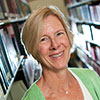This article is more than 5 years old.
Original LOVE Sculpture by Robert Indiana, at the Indianapolis Museum of Art
It is very refreshing to be at an excellent national conference with no obligations other than trying to decide which sessions to attend all day. There might be some small chance that this could be a bit stressful, simply because there were at least a dozen to choose from each time slot! The size of the conference is much nicer than at ALA (I heard the number of attendees is about 3500). They’ve done a good job of right sizing the rooms for each presentation, plenty of seating has been available and the only technology issues I’ve heard about are the slowness of the wireless. The weather has been rainy which has limited my usual new city exploration but really enhanced my focus on all the offerings of the educational sessions.
I began the day at a Serials Solution breakfast where ProQuest introduced a new web-scaled management solution, Intota. It “supports the entire resource lifecycle including selection, acquisition, cataloging, discovery, and fulfillment regardless of resource type.” Its goal is to replace the ILS.
My first session of the day was one of the contributed paper sessions. In these hour-long sessions, three people present papers they have submitted and had accepted for the conference. This first group was focused on three research projects that used different methods to assess the use of library spaces by students. The first was done at Georgetown University’s Lauinger Library, built in the brutalist architectural style (read: ugly). They conducted a photo study to discover how their library spaces were being used with a goal to gather evidence to make small scale changes. The paper, Beer Cans in the Stacks? Using a Photo Study to Reveal How Students Use Library Spaces provides the details of the methodology and results. The count data gathered was analyzed and presented using Tableau, a visualization tool. The second presentation described a study at Clark University that used a seating sweep methodology for finding the same sort data on space use. The final presentation, The Location-less Library: Examining the Value of the Library Building, examined how the loss of a library building (closed down for 2 years during renovations) affected user activities.
The second session had a panel (of 3 people from 2 institutions) that described initiatives they had going involving library publishing and undergraduates. In the first, at Illinois Wesleyan University, the library (Stephanie Kavis-Kahl) collaborated with an economics professor (Michael Seeborg)on the publication of a student peer-reviewed economics journal, Undergraduate Economic Review. The online open access journal solicits student submissions worldwide and is student managed including peer review and editorial decision-making. The library role includes advising, educating, and liaising. At Pacific University, Isaac Gilman, Scholarly Communications and Research Services Librarian, described an intensive 2 week scholarly journal publishing course that he teaches. The course objectives are: to understand and articulate the publication process, from initial manuscript submission to final publication, identify the process/resources necessary to establish a new publication, distinguish between and describe the relative benefits of different publishing models and to understand legal relationships.
In the afternoon I attended a session on Visual Literacy in Action. The presenters gave concrete examples of ways a library might incorporate the standards spelled out in the ACRL Visual Literacy Competency Standards for Higher Education.
I was introduced to the Erial Project in the next session. This was a two year long ethnographical study of the student research process. Take a look at their website for details of the project. The findings have been published in the book College Libraries and Student Culture: What We Now Know.
I finished out the day by attending the second keynote session where Henry Rollins spoke and then by going to an evening reception to learn about ArtStor’s newest product, SharedShelf (which was held at the Indianapolis Museum of Art, thus the photo of the LOVE sculpture above!). As you can tell by the brief documentation of the second half of my day, it’s been a long one and it’s time to wrap up so I can rest up for another full day tomorrow! Good night……

